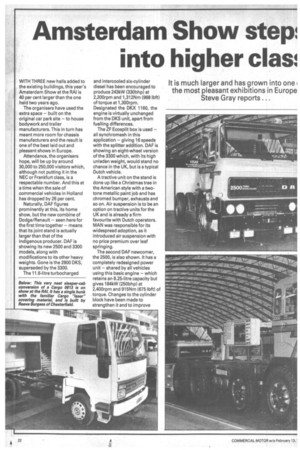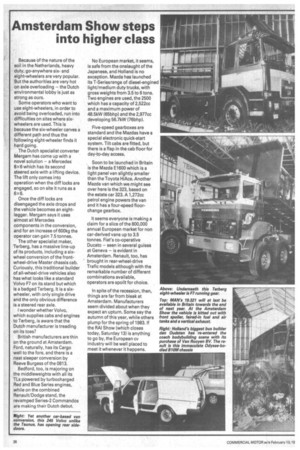Amsterdam Show step; into higher clam
Page 20

Page 22

Page 24

If you've noticed an error in this article please click here to report it so we can fix it.
It is much larger and has grown into one 1 the most pleasant exhibitions in Europe Steve Gray reports.
WITH THREE new halls added to • the existing buildings, this year's Amsterdam Show at the RAI is 40 per cent larger than the one held two years ago.
The organisers have used the extra space — built on the original car park site — to house bodywork and trailer manufacturers. This in turn has meant more room for chassis manufacturers and the result is one of the best laid out and pleasant shows in Europe.
Attendance, the organisers hope, will be up by around 30,000 to 250,000 visitors which, although not putting it in the NEC or Frankfurt class, is a respectable number. And this at a time when the sale of commercial vehicles in Holland has dropped by 26 per cent.
Naturally, OAF figures prominently at this, its home show, but the new combine of Dodge/Renault — seen here for the first time together — means that its joint stand is actually larger than that of the indigenous producer. DAF is showing its new 2500 and 3300 models, along with modifications to its other heavy weights. Gone is the 2800 DKS, superseded by the 3300.
The 11.6-litre turbocharged and intercooled six-cylinder diesel has been encouraged to produce 243kW (330bhp) at 2,200rpm and 1,312Nm (968 lbft) of torque at 1,300rpm. Designated the DKX 1160, the engine is virtually unchanged from the DKS unit, apart from fuelling differences.
The ZF Ecosplit box is used — all synchromesh in this application — giving 16 speeds with the splitter addition. OAF is showing an eight-wheel version of the 3300 which, with its high unladen weight, would stand no chance in the UK, but is a typical Dutch vehicle.
A tractive unit on the stand is done up like a Christmas tree in the American style with a twotone metallic paint job and has chromed bumper, exhausts and so on. Air suspension is to be an option on tractive units for the UK and is already a firm favourite with Dutch operators. MAN was responsible for its widespread adoption, as it introduced air suspension with no price premium over leaf springing.
The second DAF newcomer, the 2500, is also shown. It has a completely redesigned power unit — shared by all vehicles using this basic engine — which retains an 8.25-litre capacity but gives 184kW (250bhp) at 2,400rpm and 915Nm (675 lbft) of torque. Changes to the cylinder block have been made to strengthen it and to improve noise levels and reliability.
On turbocharged engines there are new cylinder heads with better porting to improve swirl and therefore combustion efficiency. Changes to fuelling equipment and turbocharger have been made, too. There is a choice of three gearboxes for the 2500 as well.
Cabs for the 2500 and 3300 are the same as those on the 2300 and 2800 respectively, and '82 model vehicles are identified by side badging on doors and quarter panels. To get the best from the new vehicles, DAF is fitting its VISAR driver aid as standard on both models.
Celebrating its success in the Paris-Dakar rally, DAF has the actual winning N-Series on show. There's another N-Series in similar colours and with as much chroming as the 3300.
On the separate DAF bus stand, there are the new MBG 200 DKTL and SB 2300 coach chassis. Due to be imported into the UK at the end of the year, the latter features a rear-mounted, DHS 825 engine which, being both charged cooled and turbocharged, gives out 184kW (250bhp) at 2,400rpm. Britain is to get the Euro Hiliner by the Dutch Smit Coach builder through Phil Errington, the Leicester importer.
Another vehicle destined for importation in the second half of the year, is the LAG Galaxy. However, unlike the vehicle shown in Amsterdam which is integral, the UK model is to have a chassis.
For its home market, DAF has changed the front-end styling of its Citibus, making it more modern looking.
Another first for Holland is the Neoplan double-decker, with DAF power. This vehicle is shown on the Neoplan stand alongside the Unibus. At Amsterdam it is shown as an invalid carrier with both side and rear entrances for wheelchairs. Kneeling air suspension lowers the floor so that the passengers can wheel themselves in. Mercedes power, in the shape of the OM 607 diesel, is used.
Because of the nature of the soil in the Netherlands, heavy duty, go-anywhere sixand eight-wheelers are very popular. But the authorities are very hot on axle overloading — the Dutch environmental lobby is just as strong as ours.
Some operators who want to use eight-wheelers, in order to avoid being overloaded, run into difficulties on sites where sixwheelers are used. This is because the six-wheeler carves a different path and thus the following eight-wheeler finds it hard going.
The Dutch specialist converter Mergam has come up with a novel solution — a Mercedes 8 x 6 which has its second steered axle with a lifting device. The lift only comes into operation when the diff locks are engaged, so on site it runs as a 6 x 6.
Once the diff locks are disengaged the axle drops and the vehicle becomes an eightlegger. Mergam says it uses almost all Mercedes components in the conversion, and for an increase of 600kg the operator can gain 7.5 tonnes.
The other specialist maker, Terberg, has a massive line-up of its products, including a sixwheel conversion of the frontwheel-drive Master chassis cab. Curiously, this traditional builder of all-wheel-drive vehicles also has what looks like a standard Volvo F7 on its stand but which is a badged Terberg. It is a sixwheeler, with only single drive and the only obvious difference is a steered rear axle.
I wonder whether Volvo, which supplies cabs and engines to Terberg, is aware that the Dutch manufacturer is treading on its toes?
British manufacturers are thin on the ground at Amsterdam. Ford, naturally, has its Cargo well to the fore, and there is a neat sleeper conversion by Reeve Burgess of the 0813.
Bedford, too, is majoring on the middleweights with all its TLs powered by turbocharged Red and Blue Series engines, while on the combined Renault/Dodge stand, the revamped Series-2 Commandos are making their Dutch debut. No European market, it seems, is safe from the onslaught of the Japanese, and Holland is no exception. Mazda has launched its T-Seriesrange of diesel-engined light/medium duty trucks, with gross weights from 3.5 to 6 tons. Two engines are used, the 2500 which has a capacity of 2,522cc and a maximum power of 48.5kW (65bhp) and the 2,977cc developing 56.7kW (76bhp).
Five-speed gearboxes are standard and the Mazdas have a special electronic quick-start system. Tilt cabs are fitted, but there is a flap in the cab floor for day-to-day access.
Soon to be launched in Britain is the Mazda E1600 which is a light panel van slightly smaller than the Toyota HiAce. Another Mazda van which we might see over here is the 323, based on the estate car 323. A 1,272cc petrol engine powers the van and it has a four-speed floorchange gearbox.
It seems everyone is making a claim for a slice of the 800,000 annual European market for non car-derived vans up to 3.5 tonnes. Fiat's co-operative Ducato — seen in several guises at Geneva — is evident in Amsterdam. Renault, too, has brought in rear-wheel-drive Trafic models although with the remarkable number of different combinations available, operators are spoilt for choice.
In spite of the recession, then, things are far from bleak at Amsterdam. Manufacturers seem divided about when they expect an upturn. Some say the autumn of this year, while others plump for the spring of 1983. If the RAI Show (which closes today, Saturday 13) is anything to go by, the European cv industry will be well placed to meet it whenever it happens.
















































